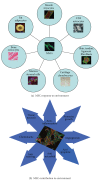Stem cells: innovations in clinical applications
- PMID: 25120571
- PMCID: PMC4121181
- DOI: 10.1155/2014/516278
Stem cells: innovations in clinical applications
Abstract
The use of mesenchymal stem cells (MSCs) as clinical therapeutics is a relatively new avenue of study for treatment of a variety of diseases. The therapeutic impact of the MSCs is based upon their multiplicities of function and interaction with host tissues. MSCs can be anti-inflammatory, antifibrotic, antimicrobial, and regenerative, all which may improve outcomes in scenarios of damaged tissues and inflammation. Although most studies focus on utilizing MSCs to direct clinical efficacy, it is the ability to orchestrate host response in surrounding tissue that is especially unique and versatile. This orchestration of host response can be applied to a variety of clinical scenarios not only through cell-cell interactions but also through production of bioactive secreted factors. These bioactive factors include small proteins, chemokines, cytokines, and other cellular regulators. These factors have the capacity to induce angiogenesis or blood vessel development, be chemotactic, and induce cellular recruitment. MSCs also have the capacity to differentiate with the implicated environment to regenerate tissue or accommodate host tissue in a cell specific manner. The differentiation cannot only be done in vivo but also can be optimized in vitro prior to in vivo administration, potentiating the versatility of the MSCs and opening avenues for corrective therapy and cell delivery of genes. The differentiation process depends on the environment with which the MSCs are put and results in active communication between the newly administered cells host tissue. Since these properties have been identified, there are a variety of clinical trials and studies being conducted on MSCs ability to treat human disease. This review outlines the potential use of MSCs, the types of tissue, and the innovative applications of MSCs for the treatment of diseases.
Figures





References
-
- Bonfield TL. Cell based therapy aides in infection and inflammation in the murine model of Cystic Fibrosis and lung disease. Stem Cell Discovery. 2013;3(2):139–153.
-
- da Silva Meirelles L, Fontes AM, Covas DT, Caplan AI. Mechanisms involved in the therapeutic properties of mesenchymal stem cells. Cytokine and Growth Factor Reviews. 2009;20(5-6):419–427. - PubMed
Publication types
LinkOut - more resources
Full Text Sources
Other Literature Sources

